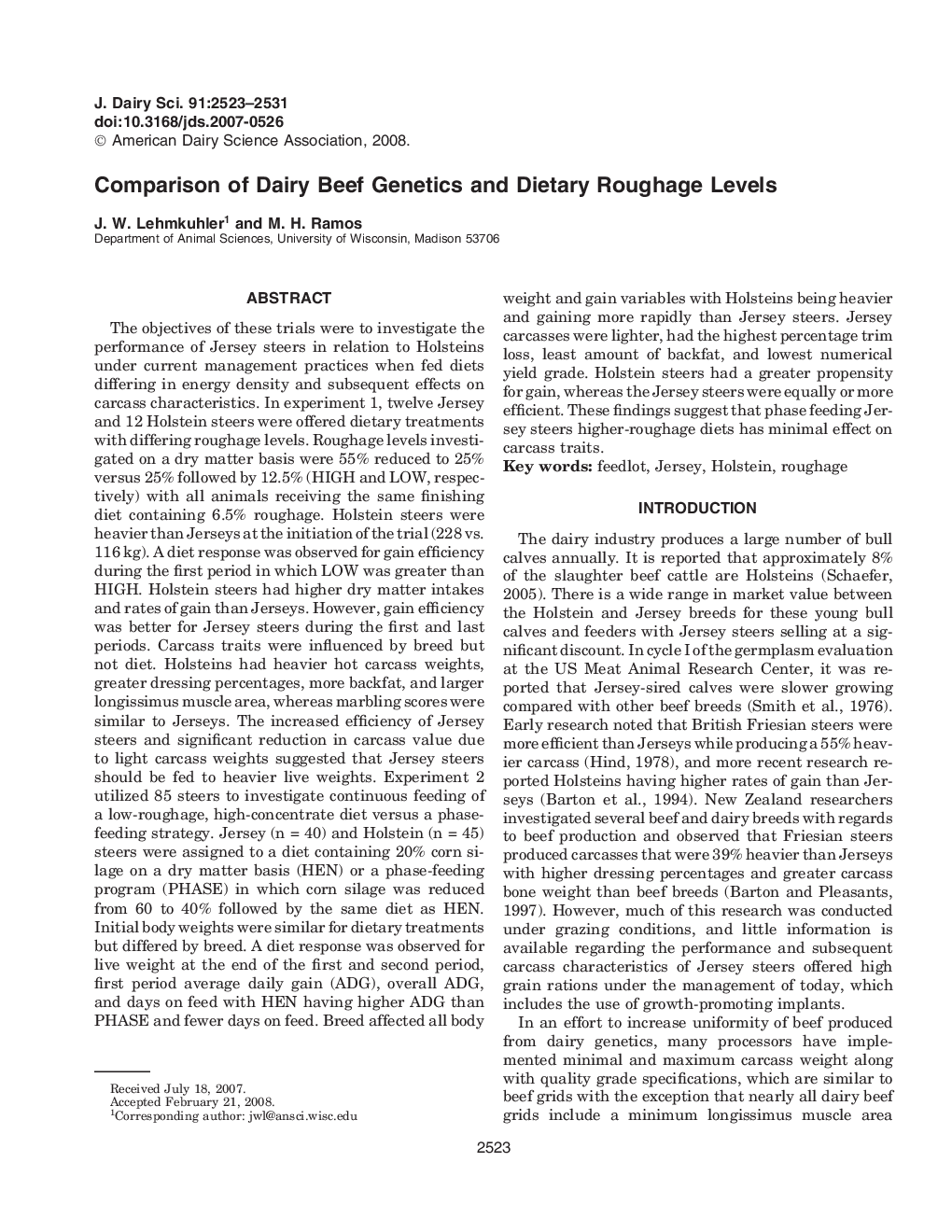| کد مقاله | کد نشریه | سال انتشار | مقاله انگلیسی | نسخه تمام متن |
|---|---|---|---|---|
| 2439973 | 1108108 | 2008 | 9 صفحه PDF | دانلود رایگان |
عنوان انگلیسی مقاله ISI
Comparison of Dairy Beef Genetics and Dietary Roughage Levels
دانلود مقاله + سفارش ترجمه
دانلود مقاله ISI انگلیسی
رایگان برای ایرانیان
موضوعات مرتبط
علوم زیستی و بیوفناوری
علوم کشاورزی و بیولوژیک
علوم دامی و جانورشناسی
پیش نمایش صفحه اول مقاله

چکیده انگلیسی
The objectives of these trials were to investigate the performance of Jersey steers in relation to Holsteins under current management practices when fed diets differing in energy density and subsequent effects on carcass characteristics. In experiment 1, twelve Jersey and 12 Holstein steers were offered dietary treatments with differing roughage levels. Roughage levels investigated on a dry matter basis were 55% reduced to 25% versus 25% followed by 12.5% (HIGH and LOW, respectively) with all animals receiving the same finishing diet containing 6.5% roughage. Holstein steers were heavier than Jerseys at the initiation of the trial (228 vs. 116 kg). A diet response was observed for gain efficiency during the first period in which LOW was greater than HIGH. Holstein steers had higher dry matter intakes and rates of gain than Jerseys. However, gain efficiency was better for Jersey steers during the first and last periods. Carcass traits were influenced by breed but not diet. Holsteins had heavier hot carcass weights, greater dressing percentages, more backfat, and larger longissimus muscle area, whereas marbling scores were similar to Jerseys. The increased efficiency of Jersey steers and significant reduction in carcass value due to light carcass weights suggested that Jersey steers should be fed to heavier live weights. Experiment 2 utilized 85 steers to investigate continuous feeding of a low-roughage, high-concentrate diet versus a phase-feeding strategy. Jersey (n = 40) and Holstein (n = 45) steers were assigned to a diet containing 20% corn silage on a dry matter basis (HEN) or a phase-feeding program (PHASE) in which corn silage was reduced from 60 to 40% followed by the same diet as HEN. Initial body weights were similar for dietary treatments but differed by breed. A diet response was observed for live weight at the end of the first and second period, first period average daily gain (ADG), overall ADG, and days on feed with HEN having higher ADG than PHASE and fewer days on feed. Breed affected all body weight and gain variables with Holsteins being heavier and gaining more rapidly than Jersey steers. Jersey carcasses were lighter, had the highest percentage trim loss, least amount of backfat, and lowest numerical yield grade. Holstein steers had a greater propensity for gain, whereas the Jersey steers were equally or more efficient. These findings suggest that phase feeding Jersey steers higher-roughage diets has minimal effect on carcass traits.
ناشر
Database: Elsevier - ScienceDirect (ساینس دایرکت)
Journal: Journal of Dairy Science - Volume 91, Issue 6, June 2008, Pages 2523-2531
Journal: Journal of Dairy Science - Volume 91, Issue 6, June 2008, Pages 2523-2531
نویسندگان
J.W. Lehmkuhler, M.H. Ramos,